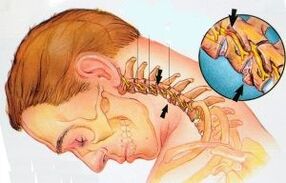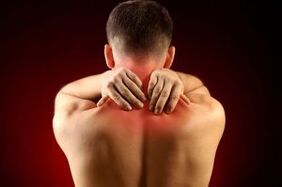
To the question: how to treat cervical spinal osteochondrosis, there is one answer: to affect the cause of the disease itself, if you are not an acute period.
Medicine treats the investigation - symptoms of the disease, not the cause.Therefore, do not expect a doctor, do not waste money on ointment, tea, injection, physiotherapy, simulator, massage.No funds listed will help you.
Therefore, it is absolutely to say that my personal experience in the treatment of cervical osteochondrosis, which I will be happy to share, hopes that it will help one of you overcome this problem.
However, success in treatment depends on several conditions:
- Your desire to help yourself;
- readiness to understand the true cause of cervical osteochondrosis;
- Compliance with strict self -discipline in treatment.
What do you need to know about cervical spine osteochondrosis
To answer the question:How to treat cervical spinal osteochondrosis,It is necessary to understand the cause of the disease well.To understand it, you need to switch to spinal anatomy.
Our spine is a strong, but flexible case for important blood vessels and nerve stems.Supporting the spine in good condition means lack of health problems.
But we, from ignorance or due to trivial attitudes to health from a young age, by caring for the spine: too much to load, take uncomfortable pose, sit for hours on the computer or at the desk during the sitting work, we spend a lot of time driving in a tense, we have a non -biased posture, and more.

The cervical spine is the most portable.It consists of seven vertebrae, including an elastic intervertebral disc.They are clearly visible in that figure.The disc makes the spine flexible and at the same time gives strength.
Each intervertebral disc is made up of fibrous rings, in which is a pulpoose nucleus.
In the cervical spine, cerebrospinal nerves and vertebral artery passes, which, through the branched nerves and blood vessels, feed not only the head together with the brain, but also the organs of the shoulder rope.
Cervical osteochondrosis is a change in the cervical spinal intervertebral disc due to physical, inflammation or mental exposure.The elasticity and strength of the intervertebral disc decreases, while their height decreases.
In the future, if you do not treat the disease, the intervertebral discs are squeezed and defective, which can cause highlights.In worse cases, the broken rings of the disc is broken, and the pulpic nucleus stands out in the form of a hernia, while squeezing the nerve ends that appear from the vertebral hole, as shown in the figure.
Therefore, the cause of cervical osteochondrosis is a change in the intervertebral disc in the cervical spine to a weak muscle background.Furthermore, even small muscle tension can lead to vertebral displacement, as a result the nerve endings are compressed, and pain occurs.
But there are many factors, as a result there are changes in the disc.These are inactive lifestyle, and hereditary tendencies, and metabolic disorders, and injuries, and salt deposition in the cervical spine and others.
How is the cervical osteochondrosis established?All symptoms indicate that as a result of changes in the intervertebral disc, conservation and blood supply to the brain, head, neck and shoulder straps are affected.Therefore, the symptoms of cervical osteochondrosis are headaches behind the head and temple, Dizziness with sharp head turn, ear noise, decreased visual acuity, hearing loss, neck pain, shoulders, shoulder blades, hands, and sometimes in the liver.
Dizziness with sharp head turn, ear noise, decreased visual acuity, hearing loss, neck pain, shoulders, shoulder blades, hands, and sometimes in the liver.
If cervical osteochondrosis is not treated, then due to affected cerebral circulation, developing diseases such as: migraine, hypertension, vegetable dystonia, hearing problems, eyes, coordination, with cardiovascular and respiratory systems.In cases of advanced, brain ischemia and stroke may develop.
Personal experience in the treatment of cervical osteochondrosis
Diagnosis is cervical osteochondrosis, I was given a neuropathologist at the age of 45.After looking at my neck x-ray picture, he wrote on the card next to the diagnosis: the height of the disc between the C5-C6 and C6-C7 vertebrae.I was tortured by frequent headaches, ringing in my ears, pain in my neck.
Questions arise:How to treat cervical spinal osteochondrosis.The doctor calmly "convinced" me that osteochondrosis is impossible to cure completely, as the intervertebral disc is defective.He sets me out of cheap, at the price, ointment and advised me to sit at the table.It is 90s, I bought ointment according to a recipe for neuropathologists in several left pharmacies.But the ointment does not lead, the pain poisoned my life.
On the proposal of contacts, I turned to paid specialist services in manual therapy with higher medical education.After him, felt the cervical vertebra, turned my head, apparently 180 degrees, it was easy, enlightening and painless.However, the procedure is clearly dangerous.The manoalist warns that for three days you have to sit at the table live, and not in your favorite pose.

I followed the suggestion for two days, and then I forgot.A few days later, my condition became the same as before visiting a doctor - a manual.This experience tells me how to treat cervical spinal osteochondrosis.After reading all the literature on osteochondrosis, I realized that I had to influence the cause of the disease freely.The doctor here is not a helper.It is not possible to change the deformation of the disc, but you can stretch the cervical spine, and thus reduce the pressure on the nerve and blood vessels.
Inside the house we always have a horizontal bar, in the morning, hanging on it, you get along a good spine, except for the neck.I tried many ways to stretch the neck, and develop my own system for the treatment of cervical osteochondrosis:
- Change the posture.It is not easy and not immediately happening, but self -discipline and motivation help me, feeling well.I often see the mirror in my posture, checking, approaching the wall: my head should touch the wall, that is, in the same line as the heel.I always try to hold the head and shoulder straight.Today, when I was 60, I had a better posture than twenty years ago.
- Daily in the morning and evening I did a "turtle" training from the Tao recovery system.Sometimes I do more often if I feel tension or hardening in the neck, upper back or shoulders.Is turtle turtle by sitting as in the figure:
- Reduce your chin on your chest, pull your head backwards with your head.Slowly delicious.Currently, the back of the neck is stretched, and the shoulders fall down;
- Slowly breathe, take the back of the head, as if you want to touch it to the back of the neck.The chin spreads, the throat spreads slightly.The shoulders rise in both heads, as if they want to touch the ears;
- Repeat this cycle 10-12 times, trying to do everything slowly.
Turtle exercises contribute to the stretching of the cervical spine, strengthening the neck and shoulder muscles, eliminating fatigue, hardening and pain, improving metabolism and rejuvenating the body.
- In addition to my "turtles" do exercises to loosen the whole shoulder, as well as sit:
- Raising and lowering your shoulders 10 times;Tilt your head slowly - Stir to the left - to the right 10 times to each shoulder;
- Tilt your head slowly - back 10 times;
- Tilt your head first to the right (right ear to the right shoulder), then slow down, stretch the neck and throw your head, roll it to the spine and left shoulder.Then from the left shoulder - to the right.Make 10 rifts to each shoulder;
- Relax, straighten the spine again, balance the weight of the tailbone, and begin to slowly make a circular movement with the trunk from left to right, then 10 times from right to left.At the same time, the head, shoulders, hands are relaxed in the rotation.
This exercise, in addition to relaxation, stimulates the body's healing force, normalizes the energy nutrition of all cells and organs.
- When I worked on a computer for a long time, I was wearing a neck collar (it could be purchased at a pharmacy).I haven't sitting in it for years, one or two hours.This allows you to keep your head straight.
- If I noticed that from an awkward pose, for example, sitting on TV or working in the country, I had a ringing in my ear or a headache, I immediately rested (as read here), after which I did a turtle.Calling and ill passing in 5-10 minutes.

The relaxation and stretching of the neck muscles and shoulder straps should be part of your daily life, so you will feel great, have a diagnosis like cervical osteochondrosis.
Before starting training, consult your doctor.
Here I would like to note that such treatment of the disease may occur beyond anxiety.If you have a period of cervical osteochondrosis with nerve infringement from hypothermia or any infection, then see your doctor and take the prescribed blockade, injection, and so on.Once the exacerbation has passed, you can use my method.
You also Note: You can relax your neck muscles with a hot water bath in your neck or caught in the bath.
Lead the mobile lifestyle, but avoid sharp head turns, heavy loads, due to tense shoulder muscles, spasms that will divert the vertebra and break the nerve roots and blood vessels in the neck.
Sleep on a small pillow, often in fresh air, turn negative thoughts to the positive so that your pressure does not cause the cervical and shoulder zones, and does not exacerbate the symptoms of osteochondrosis.

Adhere to proper nutrition.Exclude sugar and white bread, bread products from your diet.Eat more vegetables, fruits and cereals.
Now, I hope you understand how to treat cervical spinal osteochondrosis.
Trust yourself and live without pain with your cervical osteochondrosis!






















